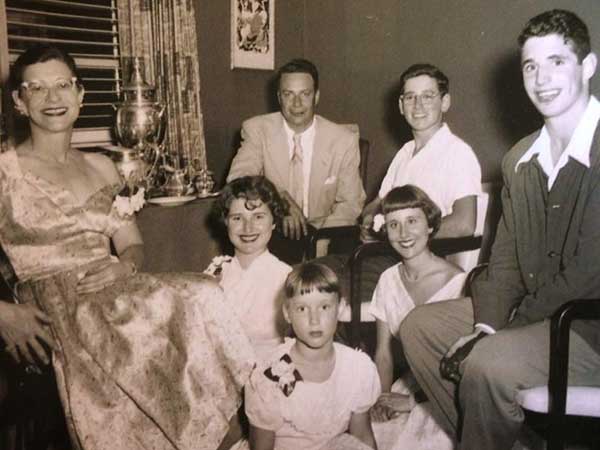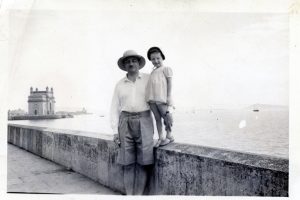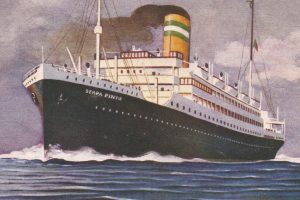
It Started and Ended with a Newspaper Article
Siblings’ journey from Nazi-occupied France to Chicago
On June 26, 1942, Charlotte Coleman, the great-aunt of JDC Archivist Abra Cohen, saw a newspaper article in the New York Herald Tribune entitled “Refugees Reach Land of Freedom from the Prison That Is Europe.” The article documented the arrival of 678 passengers on the Portuguese vessel chartered by JDC, the SS Serpa Pinto, two days earlier on June 24. Among the passengers on the ship were 50 children from Germany, Poland, Czechoslovakia, and Spain, brought under the auspices of the United States Committee for the Care of European Children (USCOM), including Henri and Miriam (Mimi) Mass. When Charlotte and her husband, Marvin Coleman, learned about the plight of these children, they were immediately moved and volunteered to foster them in their Chicago home in 1942. Abra’s father, Stuart L. Cohen of Chicago, recalled that Mimi and Henry were born in Europe, but the dire circumstances of their escape and the tragic story of the demise of their birth parents were never discussed. Now, the JDC Archives has uncovered and clarified the full story.
The Mass family was originally from Lwow, Poland (known in German as Lemberg; now Lviv, Ukraine). Henri and Mimi’s parents, Samuel and Rebecca (aka Regina), immigrated to Antwerp, Belgium, where they owned a small restaurant. Mimi, Henri, and their younger sister, Hélène, were all born there. The Mass family was able to secure seats on one of the last trains out of Belgium after the Germans occupied the Low Countries in May 1940, which enabled them to flee to the south of France. When France fell in June 1940, the Germans occupied the northern part of the country, and the Mass family found themselves in the south under the rule of the Vichy regime. In October 1940, Vichy promulgated anti-Jewish legislation, which allowed for the immediate internment of foreign Jews.
In January 1941, the Mass family was interned in the Rivesaltes concentration camp in southern France. The camp, originally built to house the influx of Spanish refugees fleeing Franco’s Spain, was overcrowded and infested with rats and vermin. Diseases such as dysentery were rife. Even though JDC was sending packages to the camp, the situation was quickly deteriorating. Regina turned to Marjorie McClelland from the Marseille office of the American Friends Service Committee (AFSC), a Quaker aid organization that was partnering with USCOM, to assist in rescuing child refugees from Europe for help. Ms. McClelland arranged the placement of Henri and Mimi, ages 6 and 8 at the time, on a convoy that left Marseille on May 14, 1942. As Hélène was deemed too young to be part of the convoy, Andrée Salomon—a key member of the Jewish resistance in France who was responsible for social welfare at the JDC-funded Œuvre de Secours aux Enfants (OSE)—placed the four-year-old with a French Catholic family in Montpellier. A letter about Hélène from this family was one of Regina’s most prized possessions.
The children traveled from France through Spain and on to Lisbon, Portugal, where the SS Serpa Pinto, a Portuguese ship that was the leading bearer of refugees across the Atlantic during the war, was docked. In addition to working with the AFSC, USCOM also partnered with JDC, which financed the children’s trips by purchasing tickets and providing guarantees that enabled the refugee children to reach safety. On June 5, the Serpa Pinto left Lisbon, docking in Casablanca on June 9 to pick up most of the remaining passengers. After one more stop in Bermuda on June 18, the ship reached Staten Island on June 24.
After the war ended, Marvin traveled back to France to ascertain the fate of the Mass family. He discovered that both Samuel and Regina had perished in the Holocaust and decided that, at the time, it was not appropriate to move Hélène out of her current circumstances and bring her to the United States. At the same time, the Colemans decided to adopt Mimi and Henri. When Hélène was 16 years old, she discovered her true identity through OSE and was able to reach out to her siblings. Mimi, Henri, and Hélène were finally reunited in 1953—a reunion so happy and longed-for that the Chicago Daily Tribune even wrote an article about it.
Stuart also remembered that the late Rabbi Edgar Siskin of North Shore Congregation Israel in Glencoe, Illinois, told him that his Aunt Charlotte began to light Sabbath candles every Friday night after she learned of the Holocaust.
Miriam spent the rest of her life in the Chicago area, where she became a teacher, married Leonard Shraiberg, and had two children and four grandchildren; she passed away in 2007. Henry is retired and now lives in Arizona; he has three children and five grandchildren. Hélène (Helena) remained in France after the war, where she became a dentist and married Bernard Waysenson, a fellow hidden child. She has two children and now lives in Zichron Yaakov, Israel.
Acknowledgment
We thank Stuart L. Cohen for sharing this story with us. This post has been published with the permission of Hélène Waysenson.





